
For years, Apple has had thousands of software and hardware engineers working on an AR and VR device. The first iteration of this project is believed to be a standalone headset, featuring high-resolution displays and M1 Pro comparable performance.
We are now seeing more references to “realityOS” – the operating system that the headset will run – leak out in Apple open source code, as the hardware gets closer… to being a reality.
Rumor mill consensus was that Apple plans to officially announce the headset this year, perhaps at WWDC or a media event in the fall. However, a recent report from Bloomberg has seeded some doubts about this timeline as apparently the hardware is facing technical challenges, and an announcement may be pushed back until 2023.
The first Apple headset is expected to be technically advanced, albeit somewhat ergonomically clunky and expensive. Analyst Ming-Chi Kuo says Apple has already started work on a second-generation headset that will be lighter and cheaper to buy. Later in the decade, it is believed Apple hopes to miniaturize the technology further and ship lightweight, discreet, AR glasses targeted at wholly replacing the iPhone.
References to realityOS have been found in the open source dyld repo and in the App Store upload logs. Perhaps surprising no one, this indicates that the headset will include an App Store for third-party developers to distribute augmented reality and virtual reality app experiences. Steve Troughton-Smith highlighted references to a realityOS simulator, which will no doubt come in handy for developers to test AR/VR apps before the actual headset hardware is widely available.
Related AR/VR hardware references have been found before, such as in pre-release builds of iOS 13. The existence of “rOS” was first reported by Bloomberg back in 2017.
FTC: We use income earning auto affiliate links. More.



Comments